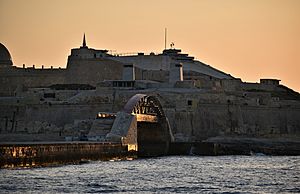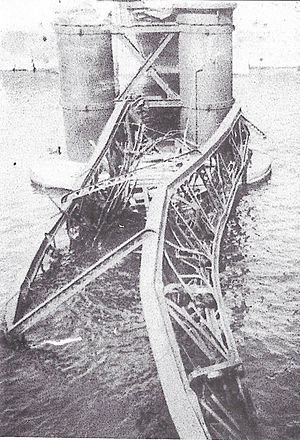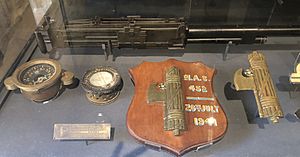Battle of Grand Harbour facts for kids
Quick facts for kids Battle of Grand Harbour |
|||||||
|---|---|---|---|---|---|---|---|
| Part of the Battle of the Mediterranean of the Second World War | |||||||
 Site of the battle - Fort St Elmo with the new bridge at the forefront, replaced in 2012 |
|||||||
|
|||||||
| Belligerents | |||||||
| Commanders and leaders | |||||||
|
|
|||||||
| Strength | |||||||
|
Coastal fortifications |
1 aviso |
||||||
| Casualties and losses | |||||||
| 1 fighter destroyed |
10 boats destroyed |
||||||
The Battle of Grand Harbour, also known as Operazione MALTA-2, was a failed attack by Italy against British ships in the harbour of Valletta, Malta. This happened on the night of 25-26 July 1941 during World War II. Special Italian navy divers, called Decima Flottiglia MAS ("X-MAS"), tried to sneak into the harbour. Their goal was to attack British ships. The attackers accidentally destroyed the St Elmo Bridge while trying to get in. After this, they were stopped by heavy gunfire from the shore defenses. The Italians suffered many losses; almost all the X-MAS group were killed or captured.
Contents
Background to the Battle
Italy's Plans and Preparations
In early 1941, the X-MAS unit had a success near Crete. They used special boats packed with explosives, called explosive boats (MT), to sink an Allied ship. Because of this success, the X-MAS unit was ordered to plan a similar attack on Grand Harbour in Malta.
The attack was first planned for late June and called Operazione MALTA-1. But bad weather and problems with their boats caused delays. The mission was then postponed to 25-26 July and renamed Operazione MALTA-2.
The plan for Operazione MALTA-2 was changed. Fewer torpedo boats (MAS) would be used. Two special manned torpedoes (SLCs) were added. These were small, underwater vehicles that one or two divers could steer. A support ship, the Diana, would carry the explosive boats and manned torpedoes closer to Malta.
One manned torpedo, piloted by Teseo Tesei, was meant to make a hole in a strong steel net under the St Elmo Bridge. This net blocked the harbour entrance. The other manned torpedo would go into a different harbour, Marsamxett Harbour, to attack British submarines. The Italian air force was supposed to fly over Malta to distract the British. These air raids were also meant to help the Italian navy find their way in the dark.
Commander Vittorio Moccagatta was in charge of the whole Italian operation. Teseo Tesei, one of the designers of the manned torpedoes, was piloting the one attacking the bridge net.
Britain's Defenses
The two main forts guarding the entrance to Grand Harbour were Fort Saint Elmo and Fort Ricasoli. These forts were manned by the Royal Malta Artillery, who operated big guns. The 1st Battalion of the Cheshire Regiment also had searchlights and machine guns ready along the shore.
In mid-July, the British learned through secret information, called Ultra, that Italy was planning a small naval attack on an island. This made the British extra careful about any unusual Italian ship movements near Malta.
The Battle Unfolds
Early Detection and Delays
The Italian force left Sicily at 6:15 PM on 25 July. The weather was good. However, British radar at Fort Madalena detected the Italian ships at 10:30 PM. This put the British defenses on high alert. The Italian ships were about 72 kilometers (45 miles) northeast of Malta.
The Italian support ship Diana dropped off its smaller boats about 32 kilometers (20 miles) north of Valletta. Then it returned to wait further north. One explosive boat was damaged while being unloaded. There were also problems with tow lines and engines, causing more delays. One of the manned torpedoes was likely damaged, making it hard to control.
By 2:00 AM on 26 July, the Italians were about 8 kilometers (5 miles) north of Valletta, already behind schedule. The planned Italian air raids did not help them navigate. The explosive boats arrived about 1 kilometer (0.6 miles) off St. Elmo after 3:00 AM. They were waiting for the bridge to explode. The manned torpedoes were launched closer to shore. The Italians did not realize that the sea current was pushing their boats eastward, away from the bridge.
Destroying the Bridge
Tesei found that his manned torpedo was damaged and he could not fix it. He started his attack at 3:45 AM, about an hour late. He could not reach the bridge or destroy the net with his torpedo's warhead by the planned time.
At 4:40 AM, the Italian commander ordered two explosive boats forward to destroy the net. The first boat got stuck in the net instead of breaking it. Its pilot jumped off and was later captured. The second pilot set his boat's fuse to explode instantly. He stayed on board and rammed the net at full speed. He was killed as both explosive boats exploded at 4:48 AM.
A part of the St Elmo Bridge collapsed. The wreckage of the bridge then blocked the harbour entrance even more strongly than the net had. The explosion put the British defenses back on full alert. Shortly after the explosion, a gun at Fort Saint Elmo fired at something moving towards the bridge. This object exploded, likely Tesei's manned torpedo, killing him.
The Italian Retreat
The explosion at the bridge was the signal for the other explosive boats to attack. But they were quickly lit up by British searchlights and came under heavy fire from the shore defenses. Two explosive boats were destroyed, and their pilots were wounded and captured. The remaining four explosive boats retreated north, realizing they could not enter the harbour.
At 5:30 AM, 30 British Hawker Hurricane fighter planes took off to hunt the Italian raiders. They attacked the remaining Italian boats. Two explosive boats were sunk by their own pilots after being attacked by the Hurricanes. One pilot died, and the other swam to Malta and surrendered.
Soon after, the British fighters met ten Italian fighter planes, and a dogfight began. One British Hurricane and two Italian planes were destroyed.
One of the main Italian torpedo boats, MAS-452, was spotted by the fort shortly before 6:00 AM. It was hit by a shell from a 6-pounder gun. Commander Moccagatta, the leader of the X-MAS unit, and other officers were killed. The remaining 11 crew members feared the boat would sink and escaped on another boat, heading back to Sicily.
MAS-452 was later attacked by Hurricanes at 6:20 AM. The boat was set on fire and exploded at 6:40 AM. The remaining nine crew members were rescued by a British boat. The last manned torpedo, piloted by Franco Costa, had mechanical problems. He and his crewmate sank the torpedo and swam ashore, surrendering to the British.
Aftermath of the Battle
The Italian attack completely failed. None of their goals were achieved. Of the 19 X-MAS special divers, 10 were killed and 9 were captured. Of the 26 crew members on the larger boats, 6 were killed and 9 were captured. Commander Moccagatta and Teseo Tesei were given special awards after their deaths for their bravery.
Italy lost all their special boats and torpedoes, except for one support boat. They also lost two fighter planes. This battle caused a delay in future X-MAS operations because so many senior officers were lost. However, in December 1941, the X-MAS unit successfully attacked Alexandria and sank two British battleships.
The British lost one Hurricane fighter plane. They also captured the Italian boat MAS-452, one explosive boat, and Costa's manned torpedo. The MAS-452 was later used by the British as a rescue boat. The St Elmo Bridge was not repaired after the attack. A new bridge was opened in 2012.
Sources



